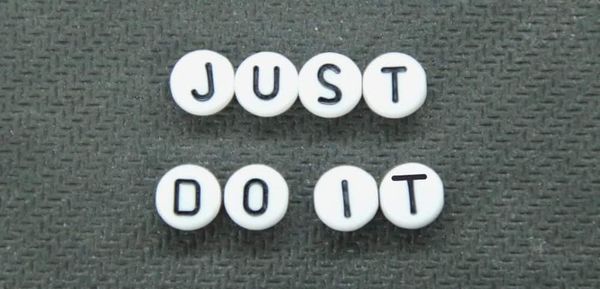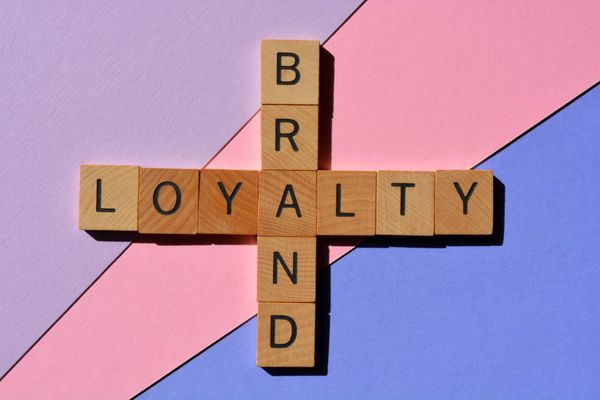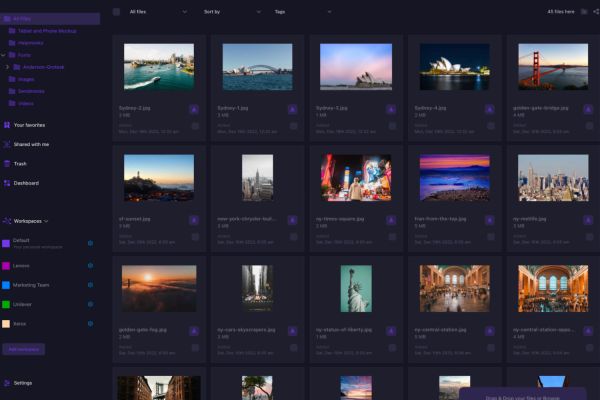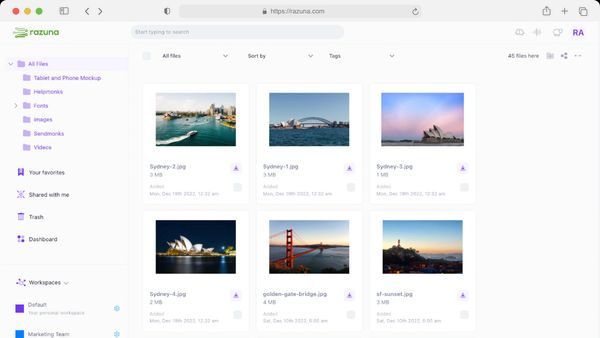
What Is Digital Asset Storage?
What is digital asset storage? This guide to digital asset storage has all the answers. Learn how to implement digital asset storage for all your teams.
Read nowDid you know there are nearly 32.5 million small businesses in the U.S.?
When you start running a business, there are a lot of issues to deal with. Not only do you need adequate inventory, but you also have to hire the right employees to help you run your company.
But this isn't enough. You also need a comprehensive marketing strategy to grow your business. A business motto, slogan, and tagline should be at the core of your marketing campaign.
So what is a slogan, motto, and tagline?
Knowing the difference between a motto vs. slogan vs. tagline is important to the success of your business. Below is a guide that highlights the differences.
A slogan is a brief, memorable phrase used to capture the essence of a specific product or service. It can be a powerful tool for shaping public perception and influencing consumer behavior.
Slogans can help capture the attention of your audience, getting them interested in your products or services. A successful slogan has several key features:
When done right, your slogan can help generate buzz for your marketing campaigns.
Slogans are often used in marketing strategies to capture the essence of your brand. It's often a short and memorable phrase. They can have several roles, including:
You can use a slogan to help establish the identity of your products and services. It usually serves as a shorthand way of referring to what your brand offers.
Need to set yourself apart from your competitors?
A good slogan can help you differentiate your products or services from its competitors. It provides a unique and memorable way of communicating your brand's key benefits and value proposition.
With a well-crafted slogan, you can build your recognition and recall. It makes it easier for consumers to remember your brand and its products or services.
Slogans can help you establish an emotional connection with consumers. You can use them to tap into their hopes, fears, values, or aspirations. When you connect with your consumers on an emotional level using slogans, they can develop a deeper, more meaningful relationship with the brand.
A slogan can serve as a call to action. They can encourage your target audience to take a specific action, such as making a purchase, trying a product, or supporting a cause.
What's more, you can use slogans to inspire consumers to adopt a certain behavior or lifestyle that's beneficial for your brand.

Brands get our attention in many ways. Using slogans is one of the most effective ways. Here are some of the most influential slogans of all time:
Although Maybelline reformed its slogan to “Make It Happen” in 2016, most of its consumers still remember this enduring marketing slogan. The wordplay made the brand's product more memorable.
A lot of brands don't choose slogans that challenge their customers. But Lay's does. The slogan is brilliant because it understands that you can't just eat one chip, making its potato chip brand the most addictive globally.
The idea behind Subway's slogan is to advertise a healthy fast food alternative. This slogan sets it apart from other fast-food restaurants as it showcases the brand's commitment to providing real, fresh ingredients.
Tesco takes a modest approach to describing its brand. While the slogan may be modest, it is memorable. It shows consumers the attention to detail they provide to all the goods and products they stock.
This timeless slogan by BMW commands respect among car lovers and owners. Its focus is on the performance aspect of the company's vehicles.
While the slogan helped change the perception of potential car buyers towards the brand, the cars were the ultimate proof of this bold claim.
Dollar Shave Club was among the first brands to use puns in their slogans. The clever play of words is not only exciting but communicates the brand's benefits.
This slogan was famous thanks to its ability to stimulate the senses. It allowed Skittles to gain traction by letting consumers experience a cross-sensory perception. From the slogan, they were able to associate the taste of the candy with the sight of rainbow colors.
With State Farm's slogan, the brand sets the tone for its customer relationships by highlighting its character. It positions itself as reliable and accessible as a neighbor. This is not only positive but also appeals to anyone looking to partner with an insurance company.
The slogan resonates with the basic function of cars—getting you to places. It shows consumers that they can drive Toyota cars and go anywhere they want. The slogan encourages consumers to embark on adventures and live life to the fullest with Toyota.
This credit card company goes for a slogan in the form of a question. It is a great way to grab consumers' attention.
The Capital One slogan starts a conversation with its audience. This invitation helps the brand position itself as a partner less explicitly.
The average person can see over 5,000 brand messages per day. To make your brand stand out, you need to create a remarkable slogan. Here are some tips to consider when creating a business slogan:
Your slogan is often one of the first things people will associate with your brand. This is why it's important that it accurately reflects the core values and messaging of your business.
It should also work together with other branded assets to create a cohesive and consistent brand image. With a well-defined brand identity, you can establish a stronger connection with your target audience and build long-term customer loyalty.
To ensure you develop a slogan with a strong brand identity, start by understanding your brand. This means conducting market research and defining your target audience. You should also have a clear understanding of your brand's mission and goals.
Your unique selling point (USP) is a crucial aspect of your brand and must be taken into consideration when creating a slogan. Your USP is what sets you apart from your competitors. It also gives customers a reason to choose your business over others.
Focusing on what makes your business special will help you craft a slogan that resonates with your target audience. As a result, you can also differentiate your brand from the competition and build a strong, recognizable brand.
Knowing your USP will also help you to identify your target audience and create a slogan that appeals to them.
While summarizing your brand story in a few words can be challenging, it can be very rewarding. Using your slogan to tell your story can be a powerful way to connect with your target audience and leave a lasting impression.
It can help create an emotional connection with your customers, helping them understand why your business exists.
Understanding your target market is crucial when creating a slogan. Your slogan should speak directly to your target audience and resonate with their needs, values, and interests.
When defining your target market, consider factors such as age, gender, income, and geographic location. This information will help you to create a slogan that speaks directly to your customers and appeals to their specific needs and desires.
If you want to build a successful brand, you need a timeless slogan. The best slogans are those that remain relevant and effective over time. This is why it's important to focus on creating a classic and timeless slogan.
To do this, avoid using words or phrases that are specific to a particular time or trend. These phrases are likely to become outdated and lose their effectiveness over time. Focus on crafting a slogan that speaks to universal values and emotions that will remain relevant for years to come.
A catchy slogan can help make your brand more memorable. This increases the chances that people will remember it and choose your brand over the competition.
To create a catchy slogan, keep it short and simple. Consider using rhymes, alliterations, or puns to make your slogan more memorable. What's more, use active language. It's also critical to ensure the slogan works effectively across various contexts—whether it's showcased on your website's footer, featured on a business card, or broadcasted over the radio, your slogan must maintain its strength and clarity.
Consistency is key when it comes to branding, and your slogan should be no exception. Your slogan should be aligned with your brand voice.
Research everything about your brand, including customers and competitors—this will help you create a message that truly resonates. Test your slogan in a focus group to refine it with feedback from a diverse range of demographics, ensuring it appeals broadly and effectively communicates your brand's unique value proposition.
For instance, if your brand is humorous, your slogan should reflect this tone and use humor to engage with your target audience. Keeping your slogan consistent with your brand voice, you can create a slogan that reflects the tone and personality of your brand.
A strong and effective slogan should be able to stand on its own. It should convey your message without the support of your logo or other branding elements. To create a slogan that can stand alone:
A slogan that expresses your commitment to delivering a great customer experience can be a powerful tool to build brand loyalty and credibility. Creating a commitment-based slogan can demonstrate your dedication to your customers, products, or services. It also conveys a sense of trust and reliability.
To craft a commitment-based slogan, be specific. Identify what you're committed to and make sure your slogan reflects that commitment. Be clear about what you offer and the benefits you provide to your customers.
While expressing your commitment, avoid making false or exaggerated claims. Honesty is key when it comes to creating a slogan. Customers are more likely to trust and choose a brand that they perceive as being honest and transparent. Make it descriptive and emotive, encouraging people to feel something while giving them a clear understanding of what the brand represents.
False or misleading claims not only damage your brand's reputation but can also result in legal consequences. For instance, Red Bull had to pay out a settlement for false claims about the slogan “Red Bull Gives You Wings.”
Don't overpromise on your slogan. Instead, focus on the brand's strengths and what you can deliver. Remember, a successful slogan not only captures the essence of your brand but also has the flexibility to grow with it over time.
Your slogan must inspire positivity. A positive slogan can have a powerful impact on customers. People are more likely to respond to a brand that makes them feel good, rather than one that creates negative associations.
To create a positive slogan, highlight the benefits of your product or service and what it can do for your customers. Use an upbeat and optimistic tone to create a positive association with your brand. Avoid negative or confrontational language.
Additionally, inspire hope. Customers are often drawn to brands that provide a sense of hope and optimism, even in difficult times.

A motto is a succinct expression that encapsulates the core values, beliefs, or objectives of a brand. Mottos help businesses express what's important to them and how they want to run their enterprise.
They can serve as a guide for your brand both internally and externally. It shows employees and stakeholders how to operate in a manner that is consistent with your brand's values, beliefs, and objectives.
Serving as a moral and ethical compass, a motto can help you make business decisions and take actions that are aligned with your brand's mission and purpose. Additionally, a motto can communicate a company's commitment to ethical and responsible business practices to customers, stakeholders, and the wider public
You can use mottos in various marketing materials. They are often used in crests, logos, or other graphical representations to convey the essence of your brand. Some of these features of mottos include:
The power of a motto lies in its ability to succinctly sum up the values of an organization or individual, making it easy for people to remember and live by. A good motto can be used to create a sense of unity among members of an organization and to help them stay focused on their goals.
Some of the roles of a motto for your organization include:
A well-crafted motto can be a source of inspiration and motivation for your business stakeholders. It inspires and motivates people by reminding them of their goals, values, and aspirations. This will help to build a strong sense of pride and commitment to the company.
You can use a motto to clarify your company's identity: It helps reinforce the company's core values, mission, and purpose. This makes it easier for employees, customers, and other stakeholders to understand what the company stands for and what it is trying to achieve.
Additionally, a motto can help define the identity of your brand by encapsulating what it stands for and what sets it apart from others.
Mottos provide direction and inspiration for decision-making and behavior. They provide a framework for employees, stakeholders, or individuals to make decisions and take actions that align with your brand's mission and purpose.
Business mottos can help create brand equity. They can bring all members of the organization together behind a common goal and purpose. This will help develop a shared sense of purpose and identity.
By reflecting the values, beliefs, and aspirations of your brand over time, mottos can leave a lasting legacy. They can help preserve the memories and achievements of the past. What's more, they can provide a sense of continuity for future generations.
It's hard to find great examples of mottos since most brands don't have them, and the ones that do have them don't use them often in advertising. However, here are a few examples:
"Semper Fidelis" is a powerful expression of the Marines' values and commitment to loyalty, honor, and duty. This motto serves as a reminder of the Marines' obligations to each other, to the country, and the mission.
It also provides a guiding principle for how Marines should conduct themselves, both on and off the battlefield.
Veritas is a Latin word that means "truth". As Harvard's motto, it highlights the importance of honesty, accuracy, and authenticity. The motto reflects the central role that truth and knowledge play in the pursuit of education and learning.
The International Committee of the Red Cross (ICRC) motto is "Inter Arma Caritas", which means "In War, Charity" in Latin. The motto reflects the ICRC's commitment to providing humanitarian aid and assistance in conflict zones.
It also communicates its commitment to upholding the principles of humanitarianism, even in the most challenging of circumstances. The motto is a symbol of hope and a reminder of the ICRC's mission to alleviate the suffering of people affected by conflict.

Looking to develop a unique business motto? Crafting a unique business motto can help you stand out from competitors and create an emotional connection with potential customers.
Here are some tips for creating a catchy motto for your business:
Start by defining your goals and values. While your values guide your business and inform your decisions and actions, goals are the specific outcomes you hope to achieve as a business.
Once you have defined your values and goals, you can use them as a starting point to develop your motto. Ensure the motto reflects your values and goals and provides a guiding principle for your business.
Keeping your motto simple is essential in making sure it is memorable and easily recognizable. Avoid using technical or specialized language that may not be familiar to the general public.
Your motto should be concise and easy to understand so that it can be easily communicated and repeated by anyone who hears it. This helps to ensure that your motto sticks in people's minds and becomes a recognizable part of your brand identity.
Your motto should be unique and different from those of your competitors. This is an important aspect of developing a successful motto that creates a strong brand identity.
When developing your motto, think about what makes your brand unique and what sets you apart from your competitors. Do some research to ensure that your motto isn't already in use by another brand.
You don't want to choose a motto that is too similar to one already in use. It may lead to confusion or even legal issues. To craft a compelling and memorable motto, start by pinpointing the essence of what your brand offers that others don't. Try to distill these unique qualities into a single, powerful sentence.
Consider employing literary techniques such as rhyme, alliteration, or puns to make your motto catchy and inspirational. While it might seem over the top, remember that some of the most iconic slogans are celebrated for their boldness. If you find it challenging to come up with something truly standout, think about using a slogan generator for initial ideas. Though these may not provide the final answer, they can spark creativity and lead to a unique phrase.
If the process becomes overwhelming, remember, assistance is just a call away. Partnering with professionals can help refine your initial ideas into a slogan that perfectly encapsulates your brand's identity and values.
Investigate the slogans used by your competitors to identify gaps or overused themes in your market. This insight will enable you to position your slogan in a way that fills a market need or speaks to an unaddressed audience, ensuring your motto stands out.
Create a motto that is positive and inspiring. This type of motto can be a powerful tool for promoting your business and building a strong brand identity.
People are more likely to engage with a brand that has a positive motto that inspires them to take action or support your business.
An effective slogan should be concise and memorable. A simple slogan, using active language and powerful verbs, creates a sense of urgency and motivation. For instance, Subway's "Eat Fresh" encourages healthier choices, and Nike's "Just do it" champions decisiveness and action across various contexts.
Ensure clarity in your slogan to enhance understanding and retention. It should represent the core values of your brand and clearly differentiate you from competitors. Utilizing key messaging helps in aligning your slogan with what your brand stands for, making it not just a tagline, but a reflection of your brand identity.
To summarize, a successful slogan is not only inspiring and positive but also clear, concise, and reflective of the brand's essence. By integrating these elements, you craft a powerful communication tool that resonates well with your audience and supports your brand's objectives.
When crafting your motto, always consider your target audience. The language should be clear and accessible to ensure it resonates well with them. If your audience is global, avoid local jargon that might not translate well or could be misunderstood.
Before you adopt a motto, test it out to see how it resonates with your target audience. Get feedback from customers, employees, and other stakeholders to see if they feel that the motto accurately represents your business. Use their feedback to refine your motto further, ensuring it effectively communicates your brand message.
Try to distill what your company offers into a single, compelling sentence. This might involve creative wordplay such as rhymes or puns, or it could be about creating an aspirational and slightly ambitious statement that captures the spirit of your brand. Consider using a slogan generator to spark ideas, but aim to finalize a slogan that is both unique and deeply reflective of your brand values.
While slogans and mottos are both short, catchy phrases, they differ in several ways. It's important to know whether to use a slogan or motto. Learn the notable differences between a motto and a slogan below.
Although both slogans and mottos can be memorable and impactful, they serve different purposes and are used in different contexts. Mottos capture the essence of an organization and its values. They can be seen as a more internal, identity-defining statement.
On the other hand, slogans are catchy phrases used to promote a product, service, or brand. They're designed to be memorable and appealing to potential customers. Business slogans are often used in advertising or marketing efforts.
The focus of a motto and a slogan can also be a difference between the two. Mottos are often centered around the values and beliefs of a brand.
They serve as a way to express the organization's mission, purpose, or philosophy. Mottos are meant to reflect the organization's identity and inspire its members or followers.
In contrast, slogans are focused on promoting a specific product or service. They're designed to grab the attention of potential customers and create a positive association with the product or service.
Slogans tend to highlight the benefits of using a particular product or service. Their focus is to generate interest, drive sales, and increase brand awareness.
Since they reflect the values and beliefs of a brand, mottos tend to have a more serious tone. They are meant to show the importance of the values they represent.
On the other hand, slogans are often designed to be catchy and attention-grabbing. This is why they tend to have a more playful or lighthearted tone. This tone also makes it memorable and engaging.
Mottos are often intended to be a long-lasting expression of the values and beliefs of an organization. You can use them consistently over time.
Contrastingly, slogans are often used for a shorter period to market a brand. They can change with time, reflecting the changing needs and goals of your brand. However, some slogans have withstood the test of time.
The audience for a motto and a slogan is also different. Mottos are often intended for internal audiences, such as employees, stakeholders, and members of the organization. They serve as a rallying cry to inspire and motivate those within the organization to work towards a common goal.
On the other hand, slogans are better suited for external audiences, such as potential customers. They help generate interest among this audience.
There are also differences in terms of the message conveyed by a motto and a slogan. Mottos convey a more abstract and philosophical message that reflects the values and beliefs of a brand.
In contrast, the message conveyed by a slogan is usually more concrete and focused on marketing a brand.
The context of use is also different between the two. Mottos are often used in a more formal context, such as on company letterhead, in company communications, or on official websites. They are often displayed in a prominent way that reflects the organization's seriousness and commitment to its principles.
Similarly, you can use slogans in a more informal context, such as in advertising materials or product packaging.
Slogans are often designed to be memorable and attention-grabbing. As a result, they have the potential to go viral and spread quickly among a large audience. It can spread fast through social media, word of mouth, or other forms of communication.
On the contrary, mottos are more serious and less focused on being attention-grabbing, so they are less likely to go viral.

A tagline is often a short expression that captures the essence of a brand. Usually, taglines are not service or product-specific. They often tend to stress the importance of a company's image and mission.
Your business tagline is what customers will directly associate with your brand for years to come. With it, you can build brand recognition.
Although taglines and slogans are both marketing tools for companies, they serve different purposes. Below is a tagline vs slogan guide to help you learn about the differences.
Slogans impart your company's product or service, while taglines highlight the image of your brand. Business slogans are more sales-driven and focused on advertising a specific product or service offered by a brand. Contrastingly, taglines are more focused on building brand awareness.
Taglines tend to be more rigid. They are often intended to encapsulate a brand's essence and remain unchanged for a long period. On the other hand, slogans tend to be more flexible and can adapt to the changing times.
Slogans are often tied to specific products and campaigns. As a result, you can change and update them frequently to keep pace with changing market conditions or demands. This means they have a shorter lifespan compared to taglines.
Since they're intended to represent your brand, taglines have a more long-term impact.
Taglines and slogans are sometimes used interchangeably. But they are not the same. To understand the differences between slogans and taglines, below are popular examples of taglines:
Crafted by Steve Jobs, the tagline celebrates creativity, innovation, and non-conformity. It also positions Apple as a brand that challenges the status quo. The tagline has cultivated a sense of individuality and defiance among Apple customers, positioning the brand as a leader in the tech industry.
The "Just Do It" slogan has become synonymous with the Nike brand. The tagline has a simple and direct message that encourages people to take action and pursue their dreams, no matter what obstacles they may face.
"Because you're worth it." is a renowned tagline symbolic of women's empowerment. It's designed to let women appreciate their beauty and self-worth. The tagline allows women to take their beauty into their own hands, making it empowering.
Now that you know what is a slogan, motto, and tagline, you can curate a well-thought marketing strategy. The aforementioned guide can help you make the right choice for your marketing efforts.
Digital asset management is also one of the crucial factors that determine brand equity. If you need a tool to help you manage your brand assets, look no further than Razuna. Sign up to get started.

What is digital asset storage? This guide to digital asset storage has all the answers. Learn how to implement digital asset storage for all your teams.
Read now
All files that your business uses is a type of digital asset. This guide explains the various types, what makes them crucial, and how best to manage them.
Read now
A digital asset management strategy is essential for your brand. This guide explores how to maximize your brand's potential with this powerful combination.
Read now
File organization is essential for any business. Here are 10 of the best file organization software options for businesses of all types to consider in 2024.
Read now
(each free accounts comes with 500 GB space)
